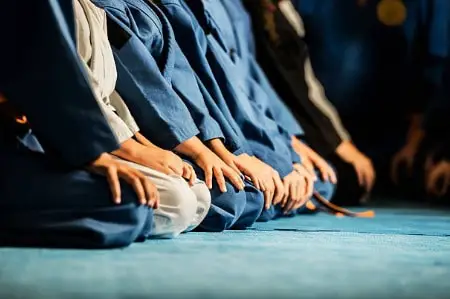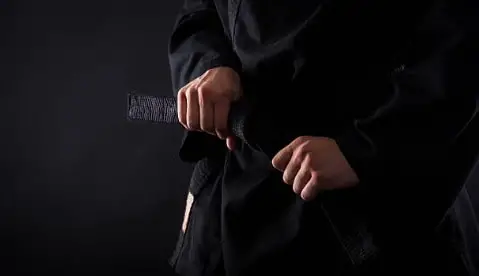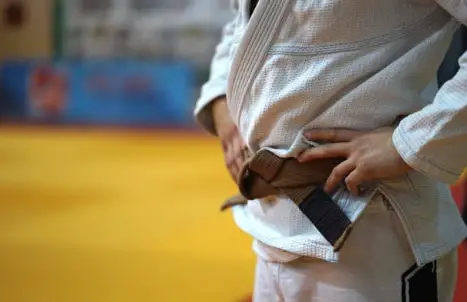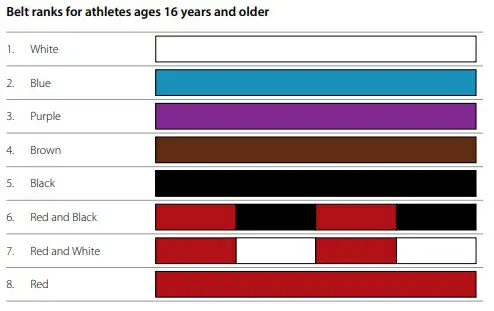
As Brazilian Jiu-Jitsu becomes more popular there are more and more questions about who is promoting students and what their authority is. Are we receiving our blue-belt from a reputable source? Why can a purple belt teach classes, aren’t black belts the only people who can teach? In this post, we’ll go through some details on who can promote in Jiu-Jitsu.
In general (and recognized by the IBJJF), a second-degree black belt in Jiu-Jitsu can promote students to the black belt. While a black belt with less than two-degrees can promote students to brown belt. A brown belt can promote to purple, and a purple can promote to blue; however, this is more common in smaller, remote towns where a black belt isn’t readily available.
Who Can Promote In Jiu-Jitsu?
A second-degree black belt in Jiu-Jitsu can promote students to the black belt. While a black belt with less than two-degrees can promote students to brown belt. A brown belt can promote to purple, and a purple can promote to blue; however, this is more common in smaller, remote towns where a black belt isn’t readily available.
Taken from section 6.3 in the IBJJF graduation guide, countries or regions where there are not enough black belts for the development of the sport, IBJJF will accept purple belt and brown belt athletes to sign as instructors. Once the minimum number (of black belts) is reached, the use of instructor status will be suspended.

It’s good to check that anyone that isn’t a black belt is still training under a black belt, especially if they are promoting students. In most cases, if there is a non-black belt teaching, they are affiliated with an academy with a black-belt instructor that they train under. These schools may also get the black-belt to come to the school to promote them.
Can A Brown Belt Promote?
Yes, a brown belt can promote students to a purple belt. they cannot promote students to brown belt. Only black belts can promote students to black belt, while only second-degree black belts can promote students to the black belt rank.
Under the IBJJF regulations, a brown belt promoting typically only occurs when there are not enough black belts in an area and the brown belt has registered to be an instructor.
Most brown belts are still training under another black-belt, but feel free to ask them who they’re affiliated with if they’re the head instructor at the school! Are they still training under a black belt?

Fun fact: It may not have been a belt promotion, but, I got my first stripe on my white-belt from a brown belt!
Can A Purple Belt Promote?
A purple belt Jiu-Jitsu practitioner can promote up to a 4 stripe blue belt. Someone that is a purple belt generally has been training for 4-7 years. The purple belt level practitioner has a large amount of knowledge and typically considered to be able to instruct lower-ranked students.
Usually, the only reason why a purple belt would be promoting, especially now that there are many black belts, is that the gym is in a remote area or the head instructor (black belt) primarily runs another gym.
It is recommended to ensure that the purple belt is still training under a black belt or has an affiliate with another gym with a black belt. If your instructor is a purple belt ask them:
- Where did they receive their purple belt?
- How long have they been training?
- Who their head coach is.
- What their coach’s level is.
- What Jiu-Jitsu affiliate are they with.
What Are The Belt Ranks In BJJ?
There are 8 (adult) belt ranks in Brazillian Jiu-Jitsu. The white, blue, purple and brown belts may have a four stripe ranking system per belt level, depending on the academy your train at. The black belt has 6 degrees, while the red/black coral belt represents a 7th-degree black belt, the red/black coral belt represents an 8th-degree black belt, and finally, the red belt represents a 9th-10th degree black belt.
- White belt
- Blue belt
- Purple belt
- Brown belt
- Black belt
- Red / Black belt (Coral belt)
- Red / White belt (Coral belt)
- Red belt

Depending on the academy you train at there are stripes given at each (or some) belt rank leading up to the black belt. These belts (white, blue, purple, brown) can only have 4 stripes. The four stripe system where a student can be considered for their next belt promotion was put in place by the IBJJF.
Stripes are not used in every academy as it is up to the instructor if they choose to use them to mark students’ progress. It must be noted that the stripe system is not consistent from different academies as it is the instructors’ discretion.
The black belt has 6 degrees with the first 3 degrees each taking three years to achieve. That means once you get your black belt it’ll take 9 years to become a 3-degree black belt. The 4th, 5th, and 6th degrees each take ~5 years each to acquire. Meaning a 6-degree black belt has had their black belt for at least 24 years!
How Long Does Each Belt Rank Take In BJJ?
The time it takes at each belt rank in Jiu-Jitsu will vary from person to person. Some people take 3 years to get their blue belt and others that take 5 years. Since the time spent at each belt rank varies some people take 15 years to achieve their black belt, while others receive it in 8 years.
I made a chart to give an idea of the average times spent training at each rank and how long you may have been training at each rank.
| Belt Rank | Average Time Spent Training At Rank | Average Total Years Of Training |
| White | 1-4 years | — |
| Blue | 2-4 years | 2-3 years |
| Purple | 2-3 years | 4-5 years |
| Brown | 1-2 years | 7-8 years |
| Black | — | 10-12 years |
IBJJF Minimum Requirements For Each Belt
The following information is taken from the IBJJF Graduation document that can be found here.
Athletes that are age 18+ have no minimum time required at the white belt level. The athlete must spend a minimum of 2 years at the blue belt level and 1.5 years at the purple belt level. Once the individual gets their brown belt they must be a brown belt for one year before being eligible for their black belt.
Once an athlete is a black belt, they must be a black belt for 31 years before being eligible for their Red/Black coral belt (7th degree). After the practitioner has their Red/Blck Coral belt for 7 years they may now get promoted to the Red/White belt. Finally, to achieve the red belt, you will have to be active for 10 years in the Red/White belt.
What Is The IBJJF?
The IBJJF is the International Brazilian Jiu-Jitsu Federation Federation. It was created by Master Carlos Gracie Jr. to officially represent the sport of Brazilian Jiu-Jitsu around the world. It’s used to organize and regulate the sport on an international level.
This federation is the reason for many of the official promotion requirements. Having requirements for promotions can help fairness and more accuracy in tournaments. The IBJJF hosts several large Brazilian Jiu-Jitsu tournaments in the world.
The World Jiu-Jitsu Championship, World No-Gi Championship, Pan Jiu-Jitsu Championship and European Open Jiu-Jitsu Championship.
If you’re curious about their guidelines for promotions click here to go to their pdf document to read.
Conclusion
Instructors that are second-degree black belts can promote students to a black belt. If your instructor isn’t a second-degree black-belt, it is ok, you’re still able to get promoted depending on their rank.
- Second-degree black belts can promote to black belt
- Black belts (less than two degrees) can promote to brown belt.
- Brown belts can promote to purple belt.
- Purple belts can promote to blue.
- Blue belts cannot promote students; however, they may give out stripes to white-belts in small rural areas.
Assuming you’re age 18+ and just starting you can expect it to take 2-3 years to be promoted to blue belt. When at a blue belt, you must be there for a minimum of 2 years before you’re able to receive your purple belt.
Once you receive your purple belt you must train at the purple belt level for 1.5 years before being eligible for your brown belt. Finally, Once you have been promoted to brown belt you must be a brown belt for 1 year before you can get your black belt.

